Nouvelles :: Nouvelles Artistes

2007-04-01 - The Making of Larry Seyer Acoustic Drums
An Exclusive Interview with Larry Seyer about his new library, Larry Seyer Acoustic Drums, now available for purchase on the TASCAM Store.
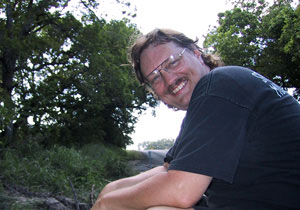 How did you start developing libraries?
How did you start developing libraries?
When Nemesys Music was starting up several years ago, they sent out a press release announcing that they were working on a software version of a sampler (later to be known as GigaSampler). I read this announcement in one of the trade magazines and noticed that the company that had made the announcement was here in Austin Texas (where I am located).
So I called them and asked "How come you guys are in Austin and I don't know about you?" I had been in Austin since 1978 and had always thought that I had kept up with what was going on in this town… And I had no idea these guys were even here! So I cold-called them and introduced myself. The founder of the company, Jim Van Buskirk and I talked for hours and we found out we had many things in common. Both of us were musicians, both were engineers, both programmed software (although I had NOWHERE NEAR the programming experience that he and his team had).
What was the first library you did for them?
They had an idea to produce a Piano Sample library and wanted to know if I would be interested in working with them on it. I said "Sure!" and even suggested which piano to record, which at the time was located in one of the studios that I worked at here in Austin - an SSL room with a well-kept Yamaha C7.
So the entire Nemesys team and I went into the studio shortly after that and recorded that Yamaha, which eventually became GigaPiano I. After the session, the Nemesys team and I stayed in close contact and our friendship and mutual respect grew.
Eventually, the founder of the company called and asked if I would be interested in producing a library of my own. Although I recorded the original GigaPiano, I did not produce the library, Nemesys did. So I agreed, but I didn't have a clue as to what to record. They suggested a bass library. I called a good friend of mine here in Austin (Spencer Starnes) and asked him if he would be interested in being the artist for the library. (Spencer and I had done many sessions here in Austin together). We recorded his Acoustic Bass here at my studio, Electric Larryland.
I really didn't know much about how to use the GigaSampler software (or editor), so Dave Govett and the team at Nemesys did most of the preparation on that library. Without them, the library would have never been completed. I recorded it, and suggested a layout. Those guys deserve the credit for it being what it is.
How did the new Drum Library come to fruition?
After the success of the Bass library, the Nemesys team suggested that I do another library. I had this idea of making this huge multi-mic'd, multi-output with bleed type of drum library. So I asked Pat Mastelotto if he would be interested in working with me on a drum library. He agreed, so we did. This was in August of '99.
After we recorded everything multi-track with bleed, I saved all of the data onto CD-ROMs (I did not own a DVD burner at the time)… I remember the data took up 90 CD-ROMS! Everything was recorded and saved in Multi-Track 32bit float format using Samplitude.
The project pretty much sat on the shelf waiting for the technology to catch up with the original vision for a year or so while I continued to work on record projects. We were all set to start working on the multi-track with bleed concept when I found out about GigaPulse. When I heard GigaPulse, we changed directions totally. We combined the files into Stereo 32 bit float files and started putting the library together in its current form. Several years later, we finished.
I understand you're a Grammy Award winner multiple times.
All of my Grammys are for work that I've done with Asleep At The Wheel. Ray Benson (the founder/leader) and I have worked together since 1986 on many projects that have won Grammys.
I started out as an engineer for Ray, but when asked, I would also play guitar, bass, keyboards, vocals and even sequence MIDI.
The Grammy's are as follows:
- 1987 Best Country Instrumental Performance String of Pars Remix Engineer
- 1988 Best Country Instrumental Performance Sugarfoot Rag Recording and Mixing Engineer
- 1993 Best Country Instrumental Performance Sugarfoot Rag Musician
- 1993 Best Country Instrumental Performance Red Wing Recording and Mixing Engineer
- 1993 Best Country Vocal Duo Blues For Dixie Recording and Mixing Engineer
- 1995 Best Country Instrumental Performance Hightower Recording and Mixing Engineer
- 1999 Best Country Instrumental Performance Bob's Breakdown Recording and Mixing Engineer
- 2000 Best Recording Package Ride With Bob Recording and Mixing Engineer
- 2001 Best Country Performance Duo or Group Cherokee Maiden Recording and Mixing Engineer
I am extremely appreciative of the chance to work with Ray on these projects. Through Ray, I have been fortunate to record some of the biggest names in the music business. (See Sidebar below)
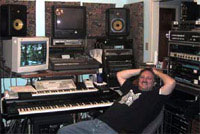 What are the tools of your trade?
What are the tools of your trade?
I started out as a totally analog guy, SSL, Neve, MCI, Tubes, etc. I'm 53 so when I started in the business 4-track analog was the preferred method for recording. (We had a 4 Track Scully and an Ampex full track in my first studio. But now, I've gone digital for almost everything. I own a Pro Tools HD rig for compatibility, but I use Nuendo for my multitrack work, Samplitude for mastering, Cool Edit (Adobe Audition) for batch processing, Logic for sequencing and GigaStudio 3 for everything else! I mix totally in the box using Nuendo on an AMD-64 Opteron system. (I'm an AMD endorsee). The Acoustic Bass was recorded using a Soundscape system, however.
What instrument is your primary for musical expression?
I'm a studio guitar player here in Austin. It is my main instrument. But I started both guitar and keyboards at the same time at age 4. My mother taught me piano, and my father taught me guitar.
But I am comfortable sequencing any instrument in GigaStudio. I was in the Army Band in the early 70's (playing sax) and was fortunate to play in big bands, stage bands, orchestras, and marching bands. This experience educated me as to what musical instruments should sound like together and how they should react within an ensemble.
What do you like about working with GigaStudio?
I just love the way that GigaStudio sounds. There is something about the way that it does what it does that makes music sound more musical to me. My dream someday is to develop a suite of guitar plug-ins for GigaStudio. Latency in GigaStudio is so low it would be great as a studio tool.
I already show up at recording sessions here in Austin with only my guitars and a laptop running Nuendo and some amp modeling software, but the latency is sort of an issue. If there were a suite of guitar plug-ins for GigaStudio, latency would not be an issue at all. Maybe someday I'll do that…
What features in GS3 are crucial to help realize your instruments? 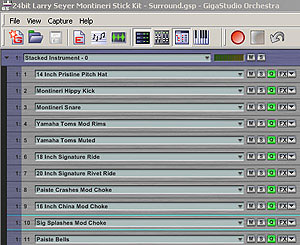 Probably I would have to start with disk streaming as one. I never ever want to make a library that uses looping inside the samples. I hate that sound.
Probably I would have to start with disk streaming as one. I never ever want to make a library that uses looping inside the samples. I hate that sound.
GigaPulse is certainly important and integral to what I want to do for any future projects. We could not have created the Larry Seyer Acoustic Drums library without the ‘stack instrument' feature of GigaStudio. So that ranks high on the list.
Being able to route each drum to its own room and each room to its own output is cool.
The MIDI mixer right in front of your face makes tuning and mixing the drums very easy. (The QuickEdit is nice too!)
As a user, I could not function without Quicksound… There are over 1,380 drum kits in the Larry Seyer Acoustic Drums library. Without Quicksound, finding the drum kit you are interested in would be next to impossible without it.
And the last thing (which probably should have been the first thing) is the sound… I love the sound!
Where do you see the future of sampling going?
The future of sampled instruments is totally within the modeling arena as far as I'm concerned. I see not only modeled instruments, but modeled everything. I believe that there will come a time in the not so distant future where every piece of gear that was ever made will be modeled and available to the end user. What will separate the expert from the novice is knowing what to use and when to use it (if at all).
I see instruments being created that allow you to pick the ‘tone' of the instrument from a palette of great sounding soundboards.
Finally, I see people using multiple computers on a regular basis to create music. I am aware the trend is to try and get everything within one ‘box'. And it certainly is convenient and the cool factor is very high. But you can't argue with physics. All things being equal, given the same power in each machine, multiple computers will always have more power than a single computer. The price of computers will continue to fall relative to the power that is contained in them, and multiple GigaStudio machine setups are a logical choice for creating the best sounding music possible.
Those who are looking for convenience over quality will probably embrace the idea of everything in the same box… And that's fine. But those who are looking for the best sound possible without compromises will use multiple computers… And if you're headed in that direction, the best choice is a multiple GigaStudio setup.
What features would you like to see in GS3 that are not there?
- User defined keystrokes.
- EVERY parameter assigned to a MIDI value and automation
- EVERY parameter can be assigned to a keystroke
- IMIDI rules for each instrument in a stack… saved with the .GSI
- Sample Offset for QuickEdit
- Mixer settings saved with the .GSI file.
- MIDI sequence playback
- VST instrument hosting
- Complete control of GigaStudio over LAN
- Multiple inputs to multiple source placements in GigaPulse.
- An aggressive and fair site license initiative that will help promote the use of the ‘multiple GigaStudio machines' concept.
What's your signal chain?
The signal chain for recording varies from project to project, but my underlying philosophy is that the shorter the signal path for the recording the better. I'm not much of a believer in doing a lot of post processing on samples. Especially noise reduction. If you choose the right microphone and the right mic-pre for the instrument you are recording, you're over half way there.
Sometimes the high dollar microphones and pre-amp choices are not the right choices. There is a microphone pre-amp that I've been using lately I just love. It's called an RNP Microphone Pre-Amp made by FMR audio here in Austin. In fact, I used it to record ALL of the rooms for the drum library in GigaPulse.
This is not to say that I don't own/use high dollar preamps… I do. The real trick is to find the right combination of microphone and pre-amp that compliments whatever you are recording, be it a sampled room, Grand piano, vocal or whatever.
The RNP mic-pre sounds very ‘airy' and ‘open' and tends to make the rooms that I sample sound more real to me.
For converters, I tend to stick with RME (or Nuendo), but we used my Pacific Microsonics HDCD converter when we recorded the GigaPiano II. Converters have gotten better and better over the last few years. Thankfully, they are not as much of an issue as they used to be. For all of the GigaPulse rooms, I used the RME/Nuendo converters.
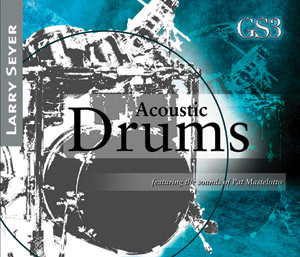 Tell us about your latest library release, Larry Seyer Acoustic Drums.
Tell us about your latest library release, Larry Seyer Acoustic Drums.
I am very excited about this library. There are so many new features built in it you can't really list them all without causing some sort of brain overload!
As I stated earlier, the library started out being similar in concept to some of the other drum libraries out now that use true multi-track format with bleed-thru from each microphone. But once we heard the sound possibilities coming from GigaPulse ™ we chose to go in a different direction. We decided to combine the various microphones that we used to record the drum components into great sounding 24bit stereo files, then allow the user to place those drum components into a room of their choice with optional microphone coloration. This approach is not only unique (as of Oct. 2004), but offers the user much more in the way of flexibility in creating new and custom drum kits.
For sure there are some fantastic sounding drum kits in the library… But there are also some totally ‘crappy' sounding drum kits. Hopefully everyone will enjoy the ‘crappy' sounding drum kits as much as I do! They are some of my favorites!
In the Larry Seyer Acoustic Drums library you will find the typical great sounding kicks, snares, toms, and cymbals that make up most modern day acoustic drum kits. And of course, there are typical pre-configured drum kits ready to go.
And the drum components sound great by themselves! Great sounding, beautifully recorded, stereo acoustic drum sounds! Drag and drop them into GigaStudio and you get instant great sounding "dry" sounding drum kits. But what makes this library unique is the addition of allowing the user to place the drums in ‘rooms' designed especially for the library. Not only are the ‘rooms' user selectable, but the positions of the drums within the rooms are selectable too! The user can also choose which microphone colors are to be imparted on the drum kits. So, pick your drums, pick your rooms, pick your mics… and go!
We can do this because we use TASCAM's GigaPulse ™ technology and some great sounding drum rooms that we recorded to be part of this library. As many musicians already know, great drum sounds only start with great sounding drums. The choice of room, placement, and microphone selection has as much to do with the overall sound of the drums as the choice of the drums themselves.
Each drum kit starts out as a collection of individual drum components. (By drum component I mean that a kick drum is a drum component of a complete drum kit; a Snare drum is another component of a complete drum kit; etc). After selecting and tuning the individual drum components for a particular kit, the entire kit is then placed in a ‘room' optimized for that drum kit. Once the correct room has been chosen for a particular drum kit, microphone colors were then added to affect the overall timbre of the kit.
Lastly, the rooms were optimized for Stereo, 5.1 and 7.1 surround placements. In other words, when you load a 5.1 surround drum kit from this library, the drum kits sound real… They sound like real drums played in real rooms. Load up a 5CH or 7CH version of any drum kit in this library, turn on your surround speakers, and prepare to be AMAZED!
The library started out being an attempt to produce only great sounding acoustic drum kits placed in great sounding rooms. But we got carried away with some of our sampling impulses and started having fun doing things that were not normal! We added a complete bank of room colors that contain unusual and weird impulse sets. We call it the "Trash Room" and this new bank takes this drum library to another place entirely. This is what I was talking about when I said we have some totally ‘crappy' sounding drum kits… The Trash Room drum kits are some of my favorites!!!
At the other end of the audio spectrum, we have added something we call the "Dry Cleaner". This unique custom created impulse is a secret weapon in our library. It can take any drum sound and make it sound better. Believe it or not… and you don't have to take my word for it… try hitting the ‘bypass' button in GigaPulse when the "Dry Cleaner" is loaded and see what the drum kits sound like without it!
And I haven't even mentioned the 1,444 MIDI files that were custom designed for this drum library… Drag and drop them in your sequencer and you have instant drum parts that are indistinguishable from a real drummer. 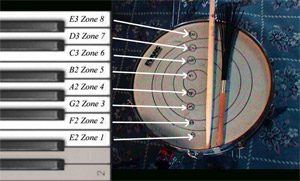 A unique feature of the drum library is our use of positional ‘zones'. The snares, toms, and hats, are not only sampled using multiple velocities, but are sampled across up to 8 positions on the drumhead. These positional ‘zones' are mapped across a full octave on the keyboard for the snare for incredibly real sounding drum parts. In other words, as you play from left to right on the piano keyboard, you are triggering the samples that were taken from up to 8 different ‘zones' on the drum.
A unique feature of the drum library is our use of positional ‘zones'. The snares, toms, and hats, are not only sampled using multiple velocities, but are sampled across up to 8 positions on the drumhead. These positional ‘zones' are mapped across a full octave on the keyboard for the snare for incredibly real sounding drum parts. In other words, as you play from left to right on the piano keyboard, you are triggering the samples that were taken from up to 8 different ‘zones' on the drum.
Lastly, we know that we went way over the top in sampling these drums, and some people are not going to want to take advantage of all of the options. And that's fine. The library comes in 2 layouts: General MIDI (GM) for those who want a simple layout that is easy to program, and in an Optimal/EXpanded (EX) layout, which gives the users all of the sound control possibilities available from the library. 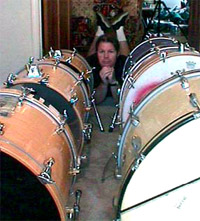 When we were editing the drum components, we noticed that there was a difference in the ‘feel' of the drums when we edited the start of the samples to be ‘as soon as the striker hit the drum'. So we started experimenting with moving the sample start time back a few milliseconds in order to keep the ‘wind of the stick' in the sample. What we found out was that the ‘wind of the stick' made the drums sound more ‘real' to us. So we decided to make 2 versions of every drum kit to allow the user to choose which version to use. One version has the samples edited to the actual drum hit (LowLatency) and the other is edited so that the ‘striker wind noise' is left in (FullAttack). Both have their usefulness and are good for different things (This is explained in the manual which everyone can download for free at www.larryseyer.com).
When we were editing the drum components, we noticed that there was a difference in the ‘feel' of the drums when we edited the start of the samples to be ‘as soon as the striker hit the drum'. So we started experimenting with moving the sample start time back a few milliseconds in order to keep the ‘wind of the stick' in the sample. What we found out was that the ‘wind of the stick' made the drums sound more ‘real' to us. So we decided to make 2 versions of every drum kit to allow the user to choose which version to use. One version has the samples edited to the actual drum hit (LowLatency) and the other is edited so that the ‘striker wind noise' is left in (FullAttack). Both have their usefulness and are good for different things (This is explained in the manual which everyone can download for free at www.larryseyer.com).
There are 115 unique sounding drum kits, but there are 12 versions of EACH drum kit for a total of 1,380 drum kits. (No joke!!!)
They break down as follows:
- 2CH, 5CH, and 7CH surround versions
- General MIDI (GM) and Optimal/EXpaned (EX) layouts
- LowLatency and FullAttack
Hopefully we have swung the baseball bat hard enough so that the ball leaves the park and there is plenty of time for all runners to make it back to home plate. If not, hey, we're darn proud of what we have done here and we'll use them ourselves!
What about future releases coming out?
We are currently working on a 5-volume GigaPulse library called Larry Seyer Rooms and Units. Each volume will contain several world-class reverb units and specialty rooms. All of the rooms will be 7 channel surround rooms with multiple placements optimized for GigaPulse. The slated release is early 2005.
Pat [drummer Mastelotto] and I have discussed producing a multiple-DVD set percussion library. He has TONS of great sounding, unusual percussion stuff. My assistant Stephen Orsak also wants to do some toy pianos and other unusual type stuff.
We have also discussed doing some very interesting things with TASCAM that should prove to be ‘eye openers' for the competition. I just love to do things out of the ordinary. And I can't wait to get started on some of the more ‘out there' things. I cannot elaborate on more than that.
How about other music interests? Are you in a band? Current projects?
I have a great deal of interest in producing music with the intent of using it as a healing tool. There have been great headways made in science correlating certain frequencies used in hemisync work with hypnosis, bio-feedback and music to assist people in returning to their ‘zero point' (a complete state of rest). I am currently working with a team of psychologists and hypnotherapists here in Austin at the Peak Performance Institute on furthering this research.
I am currently in 2 bands. One is called Unified Tribe. We are sort of a cross between Earth Wind and Fire with Manhattan Transfer vocals and hip hop beats… Funky and beautiful at the same time.
The ‘Tribe' is a collection of like-minded individuals who happen to play music together in a band. Most of them live together in the same house and have since before I joined the band (there are 15 in the band at present count). I do not live with them, however.
One of the goals of the group is to have every person on the planet be a member (wanna join?) We're currently working on our 3rd album. I play guitar, sing, mix and master the projects. The leader (Magic) and I are best friends and musical brothers.
The other band I play with is a Beatles copy band called Day Tripper. I play bass and have a blast with them also.
In between the recording projects, bands, research, and sample development, I spend time with my wife and family, 3 children and 2 grandchildren.
Larry Seyer Acoustic Drums is now avalable for purchase. Click here to order your copy.
Here's a BRIEF list of folks that Larry's worked with (visit his website for the complete list):
-
Trace Adkins
Chet Atkins
Austin Lounge Lizards
Marcia Ball
Lou Ann Barton
Roscoe Beck
Ray Benson / Asleep At The Wheel
Clint Black
Garth Brooks
Stephen Bruton
Tracy Byrd
Cindy Cashdollar
Mark Chestnut
Shawn Colvin
Rosie Florez
Vince Gill
Johnny Gimble
Merle Haggard
Tish Hinojosa
Eric Johnson
Stanley Jordan
Robert Earl Keen
Hal Ketchem
Sonny Landreth
Lyle Lovett
Tim McGraw
Reba McIntyre
Willie Nelson
Brad Paisley
Dolly Pardon
Lee Roy Parnell
Willis Allen Ramsey
Eldon Shamblin
Marty Stuart
Dwight Yokum
Squirrel Nut Zippers
"... and probably more that I cannot remember!"